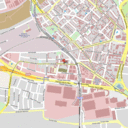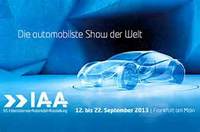"To See or Not to See" Reflections on the Frankfurt Auto Show IAA 2013
By Henny Hemmes
Senior European Editor
The Auto Channel
 |
If you remember 2001 was the year of the terror attacks in the U.S. casting a dark shadow over the show which went ahead because, according to the president of the VDA: “We cannot permit terrorist forces to take away our freedom of action.” In solidarity with the victims and their relatives and friends, all show elements and loud music were cancelled during the media and public days and there was no official opening ceremony. More than 800,000 people visited the sober show. In 2007, the exhibition space had been increased by 10 per cent, while nearly 1 million people visiting the show.
 |
The central open space was covered by a huge temporary building with an integrated 400 meter long indoor track built by Audi. There were rumors Audi had spent around 50 million euro to build it. Mercedes also had a roadway in its huge hall. Two years earlier, BMW was the first to have a track to show its cars in action and this time used the set up again for a rolling show of its brand new electric i3. The huge pavilion is located in Hall 11, the ‘other main entrance’, where people arrive by bus from the parking structure. They have to go through the building to get to the other halls, so you cannot miss the BMW Group’s news, neither from Rolls-Royce and Mini on both sides of the hall.
Also Daimler used the set up of 2011. During the pre night event, some 20 Smarts Fortwo drove around the track that is elevated above the main stage.
 |
The question is where do I go during a world premiere packed media day? As I filed the IAA Show Preview the day before the IAA opened its doors, I already knew what to expect. Even then, it is hard to figure out what you want to see. But more importantly , what you may be able to actually see. It is important to prepare a ‘route’, ignore one hall and concentrate on another that has several car manufacturers under one roof.
Believe me: time flies and I had to keep an eye on my watch in order not to talk too long, take too much time to drink coffee and even ending up without having lunch. Like me, also visitors of the show will have to make choices, or they can come back another day…
Compared to Frankfurt, the shows in Geneva and Detroit have a much more efficient set up. Geneva has expanded into a building on the other side of the freeway. But the media hardly had interest in the displays there and no car manufacturer has ‘moved’ over.
At this very moment, the NAIAS in Detroit is expanding the structure. I am not convinced about the necessity. Cobo Hall offered an efficient show and reporting from there has always been easy. Last January it was even easier, since the Media center had moved to the easy accessible and huge ‘basement’, but that was an elegant way to cover the fact that less exposition area was needed by the car manufacturers and big suppliers.
The Los Angeles auto show…? Not bad either, even though the Convention Center is much larger than the exhibition areas of Detroit and Geneva. I like it that you can take a short cut between the two halls going outside in the November sunshine and I like the light and spacious stands.
Wherever an important auto show is organized, for the media and the public, it will be business as usual. Over the past years, practically every world premiere will be announced in the weeks or days before the start of the show. Checking them out will be much easier in LA, Detroit and Geneva than in Frankfurt, where you really have to make choices: which cars to see or not to see.



